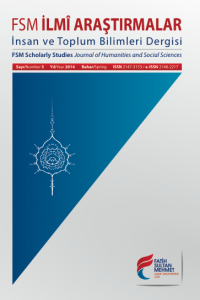Öz
İslâm âlimleri Hz. Peygamber’den bize ulaşan hadislerin ṣaḥiḥ olup olmadıklarını,
onların muhtevasını doğru anlamak ve zamanın değişen şartlarına göre yorumlayabilmek
için büyük çaba göstermişlerdir. Hadis ilimleri bu gayretlerin tabiî sonucu olarak
doğmuş ve zaman içerisinde gelişmiştir. Bu da hadisleri doğru anlamak için konulmuş
disiplin ve kaidelerin geliştirilmeye açık dinamik yapısını işaretler. Biz de bu çalışmada
hadislerin amacına daha uygun yorumlanabilmesi için çağdaş hadis yorumcusunun daha
önceden yapılmış metin anlama tekniklerine ilaveten yeni donanımlara muhtaç olduğunu
göstermeye çalıştık. Bu meyanda hadis yorumcusunun içinde yaşadığı çağın ruhuna, bu
çağı yöneten dünya görüşüne vakıf olmasının gerekliliğini ve interdisipliner perspektifin
sunabileceği müsbet katkıları inceledik.
Anahtar Kelimeler
Yorumlama; Hadis Metinleri; Zamanın Ruhu; İnterdisipliner Perspektif
Kaynakça
- Abū Dāvūd, Sulayman Bin Al-Ash‘as, “Sunan Abī Dāvūd”,Bayrūt, Dār alKitāb al-ʿArabī.
- Al-Bukhāry, Muḥammad Bin Ismāʿīl, Ṣaḥīḥ al-Bukhāry, 3rd edition, Ed. Muṣṭafā Dīb al-Bughā, Bayrūt, Dār Ibn Kathīr al-Yamāma.
- Al-Juwaynī, Abdul Mālik bin Abdullah, “al-Burhān Fī Usûl al-Fiqh”, Vafa, 1418.
- Al-Mubārakfūrī, Muḥammad Bin ‘Abdu Rahman bin ‘Abdu Rahim, “Tuhfatu al-Aḥwazī Bi Sharḥī al-Jāmī al-Tirmidhī”, Bayrut, Dār al-Kutub al-‘Ilmiy.
- Al-Qaraḍāwī, Yusuf, “al-Sunnah Maṣdrān lil Maʿrifah Wāl Haḍārah”, 2nd ed., Dār al-Shuruq.
- Al-Qaraḍāwī, Yusuf, “Kayfa Natʿāmal Maʿ al Sunnah”,2nd ed., United State of Amerika.
- Al-Qushayrī, Muslim Bin Ḥajjāj. Ṣaḥīḥ Muslim, ed. by Muhammad Fu’ad ʿAbd al-Bāqī. Bayrūt, Dār Ihyā al-Turath al-ʿArabī.
- Al-Shāṭbī, Ibrahim b. Mūsa, “Al-Muvāfakāt Fī Usūl al Fiqh”, (Dār al Marifah, Bayrūt).
- El-Naggar, Zaghloul, “Treasures in the Sunnah, A Scientific Approach, Part Two”, Cairo, Al-Falah Foundation, 2005.
- Hanioğlu, M. Şūkrū, “Max Weber - İslami Calvinistler”, Zaman Gazetesi: 02- 02-2006. http://www.zaman.com.tr/haber.do?haberno=252508
- Ibn ʿĀshūr, al-Ṭāhir, “Maqāṣid al-Shariyyah al-Islāmiyyah”, Dār al-Kitāb al-Miṣri & Dār al-Kitāb al-Lubnāni, 2011.
- Ibn Ḥanbal, Abū ‘Abd Allāh Aḥmad al-Shaybānī, “Musnad Aḥmad”, Egypt, Muʿassasat Qurṭubat, n.d..
- Ibn al-Qayyūm al-Jawziyya, Muḥamad, al-Ṭıbbu al-Nabawī, Ed. ʿAbidu alGhanī ʿAbd al-Khāliq, Bayrūt, Dār al-Fikr.
- Ibn Rajab, ʿAbd al-Rahmān, “Jāmiʿu Al-ʿUlūm wāl Ḥikam”, Bayrūt, Dār AlMaʿrifah, 1408 H..
- Karaman, Hayreddin, the article “Fakih” and “Fıkıh”, Türkiye Diyanet Vakfı İslam Ansiklopedisi, İstanbul, Türkiye Diyanet Vakfı Yayın Matbaacılık ve Ticaret İşletmesi.
- Masud, Muhammed Khalid, “Islamic Legal Philosophy: A Study of Abu Ishaq al-Shatibi’s Life and Thought”, Pakistan, Islamic Research Institute, 1977.
- Muḥammad b. Ibrāhim b. ʿAbd al-Laṭif Āl al-Shaykh, “Sharḥ Kashf al-
Öz
Throughout history, Muslim scholars have strived to understand the true meaning
of the Prophet’s (pbuh) aḥadīth and interpret them according to the changing conditions
of the time. Sciences of Ḥadīth emerged specifically to meet two objectives; first, to
distinguish authentic aḥadīth from fabricated ones via the chains of report and texts
criticism and second, to elaborate it further in order to meet any new conditions or changes
introduced into life with the passage of time. Sciences of Ḥadīth and its sub-disciplines are
open to further development. The evolving structure of the Sciences of Ḥadīth from
its succinct form to its current elaborate structure is clear evident of its dynamic and
progressive character. In this study, the researcher focuses on additional critical points in
the pursuit of gaining a better understanding of aḥadīth, such as comprehending the spirit
of the time and adopting an interdisciplinary perceptive.
Kaynakça
- Abū Dāvūd, Sulayman Bin Al-Ash‘as, “Sunan Abī Dāvūd”,Bayrūt, Dār alKitāb al-ʿArabī.
- Al-Bukhāry, Muḥammad Bin Ismāʿīl, Ṣaḥīḥ al-Bukhāry, 3rd edition, Ed. Muṣṭafā Dīb al-Bughā, Bayrūt, Dār Ibn Kathīr al-Yamāma.
- Al-Juwaynī, Abdul Mālik bin Abdullah, “al-Burhān Fī Usûl al-Fiqh”, Vafa, 1418.
- Al-Mubārakfūrī, Muḥammad Bin ‘Abdu Rahman bin ‘Abdu Rahim, “Tuhfatu al-Aḥwazī Bi Sharḥī al-Jāmī al-Tirmidhī”, Bayrut, Dār al-Kutub al-‘Ilmiy.
- Al-Qaraḍāwī, Yusuf, “al-Sunnah Maṣdrān lil Maʿrifah Wāl Haḍārah”, 2nd ed., Dār al-Shuruq.
- Al-Qaraḍāwī, Yusuf, “Kayfa Natʿāmal Maʿ al Sunnah”,2nd ed., United State of Amerika.
- Al-Qushayrī, Muslim Bin Ḥajjāj. Ṣaḥīḥ Muslim, ed. by Muhammad Fu’ad ʿAbd al-Bāqī. Bayrūt, Dār Ihyā al-Turath al-ʿArabī.
- Al-Shāṭbī, Ibrahim b. Mūsa, “Al-Muvāfakāt Fī Usūl al Fiqh”, (Dār al Marifah, Bayrūt).
- El-Naggar, Zaghloul, “Treasures in the Sunnah, A Scientific Approach, Part Two”, Cairo, Al-Falah Foundation, 2005.
- Hanioğlu, M. Şūkrū, “Max Weber - İslami Calvinistler”, Zaman Gazetesi: 02- 02-2006. http://www.zaman.com.tr/haber.do?haberno=252508
- Ibn ʿĀshūr, al-Ṭāhir, “Maqāṣid al-Shariyyah al-Islāmiyyah”, Dār al-Kitāb al-Miṣri & Dār al-Kitāb al-Lubnāni, 2011.
- Ibn Ḥanbal, Abū ‘Abd Allāh Aḥmad al-Shaybānī, “Musnad Aḥmad”, Egypt, Muʿassasat Qurṭubat, n.d..
- Ibn al-Qayyūm al-Jawziyya, Muḥamad, al-Ṭıbbu al-Nabawī, Ed. ʿAbidu alGhanī ʿAbd al-Khāliq, Bayrūt, Dār al-Fikr.
- Ibn Rajab, ʿAbd al-Rahmān, “Jāmiʿu Al-ʿUlūm wāl Ḥikam”, Bayrūt, Dār AlMaʿrifah, 1408 H..
- Karaman, Hayreddin, the article “Fakih” and “Fıkıh”, Türkiye Diyanet Vakfı İslam Ansiklopedisi, İstanbul, Türkiye Diyanet Vakfı Yayın Matbaacılık ve Ticaret İşletmesi.
- Masud, Muhammed Khalid, “Islamic Legal Philosophy: A Study of Abu Ishaq al-Shatibi’s Life and Thought”, Pakistan, Islamic Research Institute, 1977.
- Muḥammad b. Ibrāhim b. ʿAbd al-Laṭif Āl al-Shaykh, “Sharḥ Kashf al-
Ayrıntılar
| Birincil Dil | Türkçe |
|---|---|
| Bölüm | Araştırmalar ve İncelemeler |
| Yazarlar | |
| Yayımlanma Tarihi | 2 Temmuz 2014 |
| Yayımlandığı Sayı | Yıl 2014 Sayı: 3 - Bahar |


